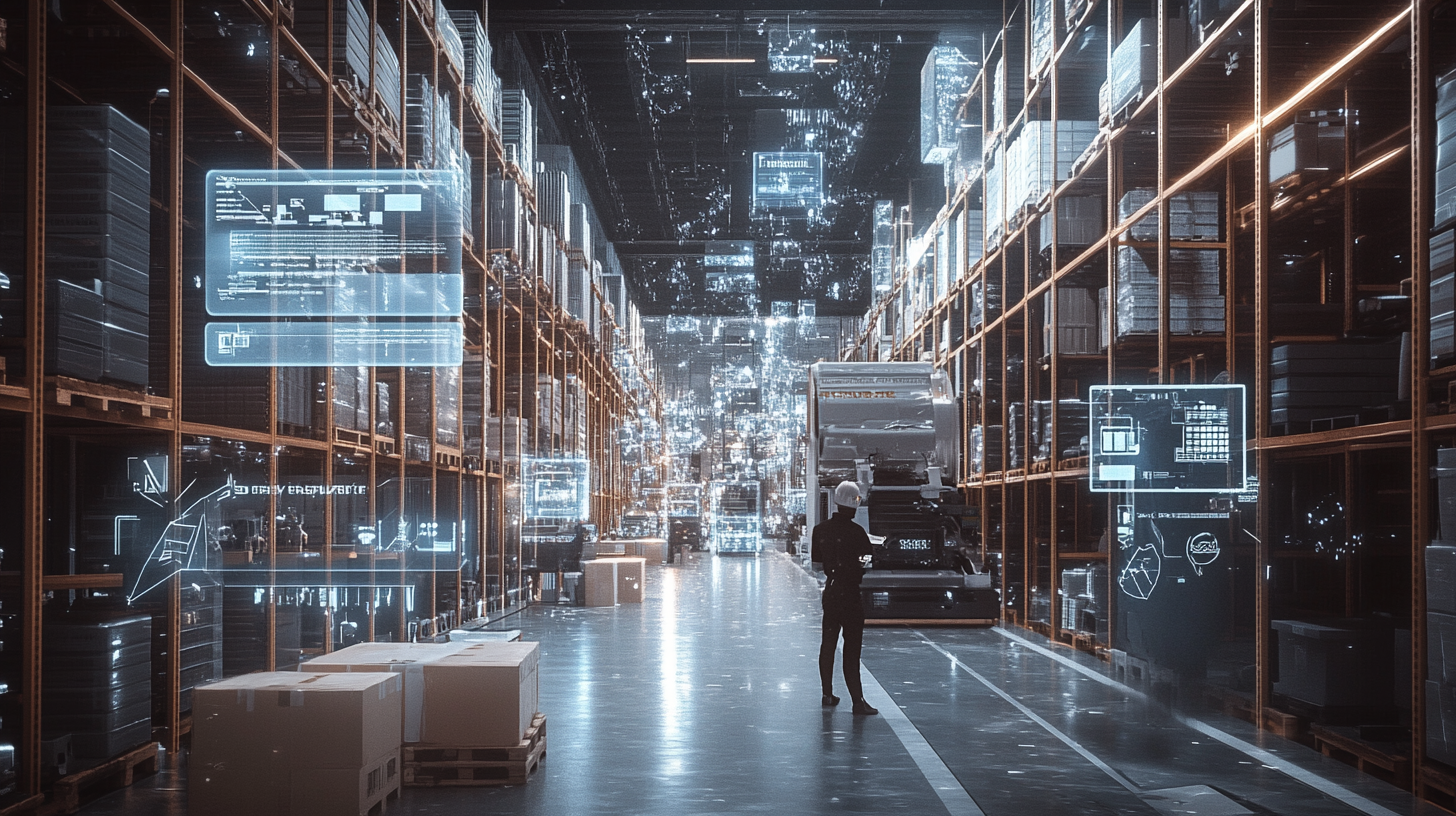Cold and fresh logistics buffer storage 4.0: Cool, clever, automated – AI-controlled pallet warehouses and high-bay solutions
Xpert pre-release
Language selection 📢
Published on: December 26, 2024 / update from: December 26, 2024 - Author: Konrad Wolfenstein

Cold and fresh logistics buffer storage 4.0: Cool, clever, automated – AI-controlled pallet warehouses and high-bay solutions – Image: Xpert.Digital
Between buffer storage and AI systems: How modern storage concepts are changing the industry
Modern logistics has developed rapidly over the past few decades and today includes a wide range of storage solutions, ranging from simple intermediate storage to specialized buffer storage for fresh and refrigerated logistics to highly automated, AI-controlled high-bay and pallet warehouses. The aim of all of these systems is to ensure the most efficient, smooth and safe flow of goods possible. “In the logistics industry, time is a crucial factor” – this is what many experts emphasize, and this is exactly why sophisticated storage concepts have become indispensable for companies that want to optimize their supply chains and assert themselves in the market. The following provides a comprehensive overview of the most important storage types and their areas of application, supplemented by relevant aspects such as sustainability, future technologies and employee relief. All content is presented to the best of our knowledge and belief, so that a practical and at the same time trustworthy image is created.
1. Basics of modern warehouse logistics
Warehouse logistics involves much more than just stacking goods on shelves. It is a strategic instrument for controlling the flow of goods and stabilizing supply chains. If you want to operate successfully these days, you need storage structures that are tailored precisely to the requirements of the company. Various factors play a role: from the type of goods stored and their perishability to the expected ordering behavior of customers to the use of space and the level of automation.
“The days when companies simply used an empty building for storage are long gone.” Today, warehouses are high-tech centers with sensitive measurement and control instruments. They enable constant monitoring of temperature and humidity, complete tracking of each individual product and an automated flow of goods that minimizes downtime and prevents bottlenecks. This overall system is often supplemented by technologies such as robotics, sensors, artificial intelligence and comprehensive warehouse management systems, which coordinate all warehouse activities centrally.
2. Buffer storage for fresh and cool logistics
Buffer storage plays an important role in fresh and refrigerated logistics. Especially when it comes to food, medicines or other temperature-sensitive products, it is crucial to have storage areas in which the goods can be temporarily stored without them losing quality or even becoming unusable. “Every minute counts in the cold chain,” it is often said in the industry. That's why short routes and fast handling processes are a central success criterion for buffer warehouses.
- Constant temperature cold storage: The right temperature ranges ensure that perishable goods do not spoil before they are delivered. Deep-freeze storage is often in the range of -25 to -28 °C, while cold storage for fresh goods requires temperatures of 2 to 8 °C.
- Short storage times and high turnover rates: quick storage and retrieval prevents food from losing its freshness. This requires seamless coordination between production, logistics and trade.
- Continuous digital monitoring: The temperature and humidity are monitored in real time. Digital sensors immediately report abnormalities so that those responsible can react in a timely manner if the cold chain is interrupted or technical malfunctions occur.
- Use of reusable boxes: Reusable packaging makes picking easier and conserves resources. In addition, standardized dimensions ensure smooth processes at interfaces such as conveyor belts, sorting systems or in trucks.
A buffer warehouse can be designed so that it only has to bridge a few hours of storage time, or it can hold inventory for several days to absorb seasonal fluctuations, production disruptions or delivery bottlenecks. “If you don’t have a buffer stock, you risk major losses,” say experts, referring to the risk of running out of inventory in the event of unforeseeable events.
3. Automatic pallet warehouses
While buffer storage is primarily relevant for short-term balancing of supply chains, automatic pallet storage is used for long-term, large-volume storage. Enormous quantities of goods can be stored here, often in a very small space. The advantages are obvious:
- High storage density: By using the storage space vertically, more pallets can be stored per square meter.
- Automated storage and retrieval processes: stacker cranes or autonomous industrial trucks transport the pallets. Central control software manages order orders, storage locations and picking.
- Minimized error rate: Since manual intervention is reduced, the risk of incorrect picking or damage to the goods during transport is reduced.
- Relief for employees: Heavy physical work such as lifting pallets is no longer necessary. The workforce can focus on supervisory and strategic tasks, which often increases job satisfaction.
Automation in the warehouse has long been standard in many industries. “Automation is no longer just a trend, but a necessity,” is the tenor in large logistics companies. Especially for rapidly rotating goods such as drinks or promotional items in retail, automatic pallet warehouses are a suitable means of dealing with peak loads in a short time.
4. High bay warehouse (HRL)
High-bay warehouses are, so to speak, the pinnacle of storage systems. They can rise up to 45 meters in height and therefore offer very efficient use of vertical space. When it comes to construction, a distinction is made between, among other things, built-in warehouses and free-standing silo warehouses. In a built-in warehouse, the racking system is integrated into an existing building, while a silo storage system is characterized by the fact that the racking system also forms the building shell.
Other features of high-bay warehouses:
- Storage and retrieval machines (RBG) or shuttle systems: These automated systems move in the aisles between the high shelves and lift the pallets to the appropriate heights. Shuttle systems are often faster and more flexible than classic storage and retrieval machines.
- Integrated warehouse management systems (LVS): A professional LVS manages all inventory centrally, controls storage and retrieval and plans picking. This allows capacities to be optimally utilized and delivery times to be shortened.
- Safety and maintenance: Because work is carried out at great heights and a lot of technology is used, regular safety checks and maintenance intervals are essential. “Safety is the top priority in high-bay warehouses,” emphasize logistics experts, especially since accidents at great heights can have serious consequences.
High-bay warehouses are used in many industries: from the automotive industry to the chemical and pharmaceutical industries to wholesale. They are an extremely attractive option, especially when there are high turnover rates and limited land space.
5. AI-driven automated warehouse systems
The next evolutionary step in warehouse logistics is the integration of artificial intelligence (AI). “Artificial intelligence can take the efficiency of storage systems to a whole new level,” say experts. AI algorithms evaluate large amounts of data to better understand and continuously optimize warehouse processes.
- Predictive analytics and predictive maintenance: With the help of predictive analytics, machines can be maintained before malfunctions occur. This reduces downtime and allows the warehouse to operate continuously.
- Dynamic adjustment of processes: AI recognizes, for example, seasonal patterns or order peaks and can adjust picking behavior accordingly. In addition, the system learns from the past and derives forecasts for the future.
- Resource conservation: AI-optimized processes use energy and space more efficiently. For example, robots can plan their routes so that there are as few empty trips as possible.
- Increased system performance and redundancy: AI systems are designed to automatically find alternative routes in the event of disruptions and thus maintain the flow of goods. Multiple structures and redundant control elements reduce the risk of complete failure.
However, you need a solid database and appropriate IT infrastructure to successfully implement AI systems. This shows that logistics is increasingly becoming a data discipline in which digital competence and IT security play an important role.
6. Advantages of automated storage systems
The implementation of automated warehouse solutions – whether with or without AI – brings with it a variety of advantages:
- Increased efficiency and productivity: Automation reduces waiting times, optimizes transport and speeds up picking. This means that more goods can be processed in a shorter time.
- Improved product availability: Through more precise inventory management, items can be found more quickly and can be delivered more quickly. This increases customer satisfaction and reduces inventory shortages.
- Reduction of errors: Sources of errors such as incorrect labeling, incorrect storage or picking occur significantly less often thanks to digitally controlled processes.
- Optimized use of space: High-bay warehouses or compact shuttle systems in particular make maximum use of the available space. This reduces the costs per stored product.
- Relief for employees: Monotonous and physically demanding tasks such as lifting heavy loads are no longer necessary. Employees can concentrate on more complex activities, such as monitoring and controlling processes or quality control.
- Sustainability: Less energy and resource consumption through improved system utilization and forward-looking planning. Shorter routes and well-thought-out route planning also reduce the carbon footprint.
7. Sustainability and safety as central issues
In times of climate change and social change, sustainability is playing an increasingly important role. “Green logistics has long been more than just a buzzword,” emphasize industry experts. Modern storage systems are therefore increasingly being designed to not only be efficient, but also to reduce the ecological footprint. Examples of this are:
- Energy-efficient storage and retrieval machines: Electrically powered vehicles with recuperation systems can recover braking energy and feed it back into the circuit.
- Intelligent lighting systems: Motion detectors and LED technology significantly reduce power consumption in the warehouse.
- Thermal insulation and cooling concepts: Optimum insulation is crucial in order to minimize the required cooling energy, especially in buffer warehouses for fresh and refrigerated logistics.
Security is another key issue. Where large devices and people work together in a small space, there must be clear rules. Automated systems are usually safer because there are fewer sources of human error, but at the same time they require comprehensive protective measures to ensure that no one gets into machine areas or is endangered by autonomous robots. Regular training for the workforce and transparently communicated emergency plans are therefore essential.
8. Areas of application and future prospects
The storage concepts described are used in almost all sectors of the economy. The important areas of application include:
- Food industry: Buffer storage for fresh and refrigerated logistics is of central importance here. Short turnaround times mean that production fluctuations and delivery peaks must be flexibly cushioned.
- Automotive and mechanical engineering: High-bay warehouse for large and heavy components, some of which have to be delivered just in time.
- Chemistry and pharmaceuticals: Highest requirements for cleanliness and temperature control, sometimes also storage of dangerous goods, which must meet strict legal requirements.
- E-commerce and retail: Automated pallet warehouses and AI-controlled picking systems handle enormous order volumes, especially during peak periods such as before holidays.
The future of warehouse logistics promises further innovation, particularly through the increased use of AI, robots and connected systems. In “smart warehouses,” devices communicate with each other independently. Intelligent sensors constantly check the environment, while algorithms continuously optimize the flow of goods. In the long term, there could even be completely autonomous camps in which human staff only have to intervene in exceptional cases.
However, the necessary change represents a major challenge for many companies. In addition to high investment costs, specialist knowledge and acceptance among the workforce are also crucial. “Successful implementation requires a corporate culture that is willing to learn,” is an often-quoted motto in the industry.
9. Warehouse logistics are as diverse as the requirements
From simple buffer storage for fresh and refrigerated logistics to fully automated, AI-supported high-bay or pallet storage – warehouse logistics is as diverse as the requirements placed on it. Every storage concept has its right to exist and fulfills certain tasks in the supply chain. Choosing the right system depends on numerous factors, including product type, turnover rate, available space and budget.
Automated warehouse systems with AI components offer a high level of efficiency, error prevention and adaptability. However, they require a solid database, careful planning and qualified personnel to realize their full potential. Buffer storage for fresh and refrigerated logistics remains indispensable as they keep sensitive goods in an optimal temperature range and quickly forward them if necessary.
“The future belongs to flexible, intelligent and sustainable storage systems” – this statement from the industry shows where the journey is headed. Sustainability and safety are becoming increasingly important, and companies that invest in modern warehouse technology are creating a competitive advantage. Many companies are already modernizing their warehouses and relying on automation, not least due to increasing e-commerce volumes and customer expectations for fast delivery times.
Nevertheless, the human element remains important. Even if many processes are automated, specialists are needed to monitor, maintain and optimize the systems. A holistic concept that harmonizes technology and people will therefore continue to be the key to success in the future.
A look into the crystal ball reveals that robotics, AI, big data and sustainability will be among the most important drivers of further development. More and more companies are realizing that intelligent storage systems not only reduce costs, but also promote resource conservation. Intensive research continues to be carried out, particularly in the area of refrigerated logistics, in order to reduce energy consumption and emissions. Technology is advancing rapidly, and new solutions that we may not even be able to imagine today are already in the starting blocks.
Modern warehouse logistics has long been more than just “arranging pallets”. It is a highly complex, technical interplay of processes, systems and human expertise that is constantly adapted to new challenges. From simple buffer storage for perishable goods to fully automated AI high-bay warehouses, each storage concept serves an important purpose in the supply chain and helps keep companies competitive and innovative. Anyone who invests in the right storage solution today is laying the foundation for a successful future in an increasingly globalized and networked economic world.
Xpert partner in warehouse planning and construction
Short and sweet: From buffer storage for fresh logistics and refrigerated logistics warehouses to automated AI high-bay warehouses and pallet warehouses
Modern logistics includes a wide range of storage solutions, ranging from simple buffer warehouses to highly automated AI-driven systems. Here is an overview of the different bearing types and their applications:
Buffer storage for fresh and cool logistics
Buffer storage plays a crucial role in fresh and refrigerated logistics. They serve as temporary interim storage to compensate for fluctuations in the supply chain and ensure that production, picking and delivery run smoothly.
Special features of fresh logistics:
- Cold storage with constant temperatures (e.g. -25 to -28°C for frozen food)
- Short storage times and high turnover rates
- Permanent digital monitoring to minimize lying times
- Use of reusable boxes for simplified order picking
Automatic pallet warehouses
Automatic pallet warehouses offer an efficient solution for storing large quantities of goods. They are characterized by the following features:
- High storage density and efficient use of space
- Automated storage and retrieval processes
- Reduced error rates and short lead times
- Relieving employees of heavy physical work
High bay warehouse (HRL)
High-bay warehouses can be up to 45 meters high and are particularly suitable for companies with limited space and high storage volumes:
- Optimum utilization of the available storage space
- Possibility as built-in storage or free-standing silo storage
- Use of storage and retrieval machines (RBG) or shuttle systems
- Integration of warehouse management systems (LVS) for efficient process control
AI-driven automated warehouse systems
The latest generation of storage systems uses artificial intelligence for even more efficient processes:
- AI-based algorithms for monitoring and optimizing warehouse processes
- Automatic adjustment and improvement of processes
- Predictive maintenance to avoid unplanned downtimes
- Increased system performance and redundancy
Advantages of automated storage systems
Implementing automated storage solutions offers numerous benefits:
- Increased efficiency and productivity
- Improved product availability and shorter delivery times
- Reducing errors and improving quality control
- Optimized use of space and energy efficiency
- Relieving employees of monotonous and physically demanding tasks
Choosing the right storage system depends on various factors such as storage volume, product type, available space and throughput requirements. From simple buffer warehouses to highly complex AI-controlled systems, modern logistics offers solutions for every requirement to keep companies competitive and efficient.

Xpert.Plus warehouse optimization - high-bay warehouses such as pallet warehouses consulting and planning
We are there for you - advice - planning - implementation - project management
☑️ SME support in strategy, consulting, planning and implementation
☑️ Creation or realignment of the digital strategy and digitalization
☑️ Expansion and optimization of international sales processes
☑️ Global & Digital B2B trading platforms
☑️ Pioneer Business Development
I would be happy to serve as your personal advisor.
You can contact me by filling out the contact form below or simply call me on +49 89 89 674 804 (Munich) .
I'm looking forward to our joint project.
Xpert.Digital - Konrad Wolfenstein
Xpert.Digital is a hub for industry with a focus on digitalization, mechanical engineering, logistics/intralogistics and photovoltaics.
With our 360° business development solution, we support well-known companies from new business to after sales.
Market intelligence, smarketing, marketing automation, content development, PR, mail campaigns, personalized social media and lead nurturing are part of our digital tools.
You can find out more at: www.xpert.digital - www.xpert.solar - www.xpert.plus


























